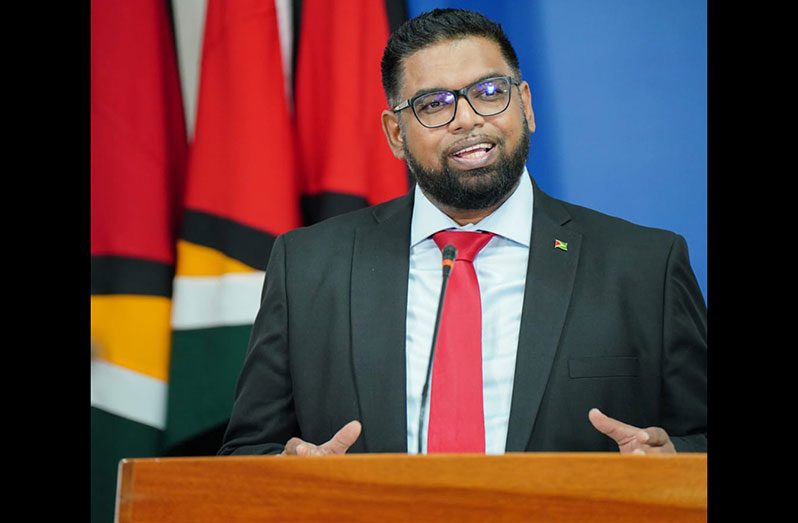–President Ali says resources will be used to enhance traditional economy, build new, sustainable sectors
REVENUE generated from the local oil and gas sector is expected to catapult Guyana to the ranks of wealthiest countries in the Western Hemisphere, thereby increasing the government’s fiscal space to invest in initiatives geared at expanding the economy and improving the overall welfare of citizens.
“Guyana is now poised to be one of the wealthiest countries in the hemisphere… [we intend to] employ the gains from exploiting these deposits into initiatives geared at expanding the economy, improving competitiveness, giving people the best social services, increasing productivity, enhancing food production and building new sectors,” President Dr. Irfaan Ali said in his keynote address during a virtual faculty workshop on the microeconomics of competitiveness, hosted by Harvard Business School, on Monday.
In painting a vivid image of what is expected from the oil and gas sector in the near term, Dr. Ali said that by 2025, operating cash flow, based on total investment, is expected to reach US$3.5 billion.
The performance of this sector is expected to improve even further as the years go by, since the success rate is 80 per cent and there are already 26 commercial discoveries.
ExxonMobil’s first offshore Guyana project, Liza Phase One, began producing in late 2019, well ahead of the industry’s average for development time. Liza Phase Two remains on track to begin producing oil by early 2022.
Liza Phase Two will produce up to 220,000 barrels of oil per day at peak rates, using the Liza Unity FPSO. Late last year, the oil giant, following an agreement with the Government of Guyana, decided to proceed with the Payara field development offshore Guyana.
Payara is ExxonMobil’s third project in the Stabroek Block, and is expected to produce up to 220,000 barrels of oil per day, after start-up in 2024. The US$9 billion development will target an estimated resource base of about 600 million oil-equivalent barrels.
And even as the industry gears up for further production, there are six drill ships operating offshore Guyana, namely the Stena Carron, the Stena DrillMAX, the Noble Bob Douglas, the Noble Tom Madden, the Noble Don Taylor and the Noble Sam Croft.
Westmount Energy had said that Guyana, with its positive prospects and vast potential, remains one of the few areas of “blue-chip” interest in high-impact exploration. Investopedia defines blue-chip stocks as secure investments because they pay out dividends as well as consistently and steadily grow over time.
As it is now, Guyana is expected to end the year with over US$600 million in its Natural Resource Fund (NRF).
Revenues reaching close to US$70 million could be earned from the sale of the country’s final oil lift for this year, which was completed a few days ago.
Guyana had earned close to US$80 million from the sale of its penultimate lift for 2021, taking the total earnings in the NRF to over US$534 million.
According to the Bank of Guyana’s monthly report on the NRF, the aggregate sum moved from US$436,132,855.53 in September to US$534,016,987.03 in October.
This is as a result of the country earning G$16,757,920,000 from “profit oil” and G$3,647,083,000 (approximately US$17 million) in royalties from ExxonMobil.
A report compiled by the Inter-American Development Bank (IDB) early this year showed that earnings from Guyana’s oil and gas sector could reach US$31 billion (roughly G$6.7 trillion) by 2035.
Moving ahead, considering the immense direct and indirect benefits that will accrue to Guyana from the oil and gas sector, President Ali said there will be key initiatives for managing the sector, with some already in the draft stage.
He said that among those initiatives are the draft Local Content Policy and Bill, building local content for audit, revising fiscal management, and establishing an accountability and transparency framework.
“Resources will be used to enhance the traditional economy and create a pathway to build sustainable and diversified sectors to bring long-term prosperity,” Dr. Ali said.
The overarching plan, as outlined by the Head of State is to build an equitable society, in which every Guyanese person, irrespective of the region in which they live, irrespective of their ethnic or religious background, would have an equal opportunity and stake in the development of the country.
He said that in order to achieve that plan, which will see prosperity for all, it is absolutely necessary to have the correct framework for development.
The need to build Guyana’s human capacity through universal education was listed by the President as a centrepiece of personal empowerment.




.jpg)









